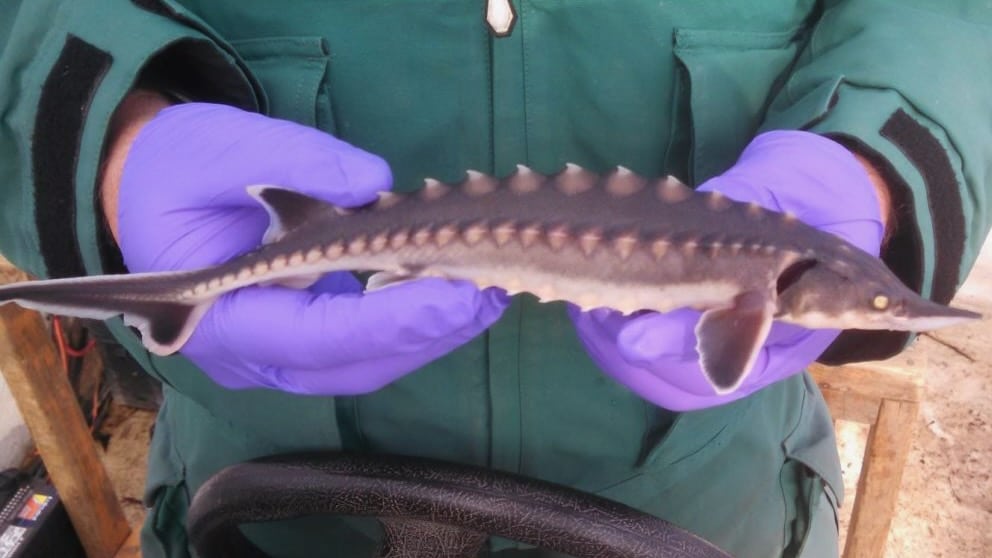To bring a fish back from the brink of extinction, people must push for protection over pollution.

An Atlantic sturgeon. (Credit: Delaware Department of Natural Resources and Environmental Control)
This article, by high school student Annette Khosravi, was produced out of News Decoder’s school partnership program. Annette is a student at The Tatnall School, a News Decoder partner institution. Learn more about how News Decoder can work with your school.
This story won second prize in News Decoder’s 14th Storytelling Contest.
In November 2022, a group of people gathered in Philadelphia to mourn a fish.
It was an event staged by an environmental organization, Delaware Riverkeeper Network, to bring attention to the feared extinction of the Atlantic sturgeon — harvested for caviar — and show the agencies that contribute to the rapid decline of the fish that they need to change the way they run things.
If they don’t, the last 250 Atlantic sturgeon spawning adults will need an actual funeral.
Atlantic sturgeon are big fish that can grow up to 14 feet long. They are dark blue/black, with rows of scutes around their bodies and they have a white belly. Atlantic sturgeon do not have teeth, so they have a vacuum-like mouth that they use to pick up food from the water.
The Delaware River is an important waterway in the United States. It provides drinking water to over 13 million people. The river is 330 miles long and goes through five states: Delaware, Maryland, Pennsylvania, New Jersey and New York. The deepest part of the river is in Narrowsburg, New York and is 113 feet deep.
From caviar to conservation
According to the Delaware Riverkeeper Network, the Atlantic sturgeon population first started to decrease because of overfishing by the caviar industry. It then continued to deteriorate because of oxygen depletion caused by algae blooms.
In 2022, The Environmental Integrity Project, an environmental advocacy organization in Washington, D.C., collected data from waterways in all 50 states in the United States to measure the impact of the Clean Water Act 50 years after it was passed.
The project found that 97.3% of Delaware’s rivers and streams are deemed impaired.
Atlantic sturgeon is a genetically-special population of fish only found in the Delaware River. It used to be abundant, said Anneka von Rossum, advocacy and policy coordinator at the Delaware Riverkeeper Network.
“You could cross the river from one side to the other on the backs of the sturgeon,” von Rossum said.
Cleaning up industrial waste
The Delaware Riverkeeper Network also launched a petition drive to get the Delaware River Basin Commission and other government agencies to raise the standard for dissolved oxygen.
The standard the Commission had set was 3.5 grams per meter of dissolved oxygen, but for the Atlantic sturgeon to live a healthy life they would need 6.0 to 6.35 grams per meter of dissolved oxygen.
The population of the sturgeon now is now less than 0.5% of what the overall sturgeon population once was.
Delaware’s pollution rate is high compared to the rest of the country. According to The Environmental Integrity Project, 50% of the rivers and streams sampled were classified as “impaired” because of how polluted their water is.
According to the Delaware River Basin Commission, increased industrial activities and population growth in Delaware in the 18th century first polluted the water. Waterborne illnesses then led to a decline of the population of fish that migrated to the river. Pollution worsened during World War II from industrial waste and public waste.
The river became so dirty that the paint on ships passing through the river or docking in it would turn brown and fall off because of all the toxins in the water.
Bringing “dead zones” back alive.
The Delaware River Basin Commission, a federal interstate agency, was created in 1961 to clean up the pollution. Some of the estuaries were considered ‘dead zones’ — the oxygen level in the water of these estuaries was so low, no fish or other aquatic organisms could survive.
In 1967, the same water quality standards were adopted for all interstate river basins in the United States. A year later, the U.S. Congress passed The Wild and Scenic Rivers Act. The lower part of the Delaware River is now designated a wild and scenic river. That means that the river’s water quality and overall condition is being protected by that law. Finally, in 1972 Congress passed The Clean Water Act, to control the water quality of all the waterways in the United States.
The Delaware River is now seen as one of the world’s top water quality success stories.
“In 2020 the Delaware river was named the river of the year in the United States,” said von Rossum.
Bill Schluter is a fisherman who has gone fishing in the Delaware River off and on since he was young. “The river has become cleaner in just about every way you measure it, including visually,” said Schluter. “The Delaware River provides more variety than some of the other bodies of water I fish in.”
Now to fight fracking
The Delaware Riverkeeper Network is working on its next project — pushing the Commission to fully ban fracking on the Delaware River Basin. Fracking is essentially a process that removes oil and natural gas from rocks. It can result in leaked methane, a greenhouse gas. Fracking also uses a significant amount of water and can contaminate it.
The Commission currently allows the importation of fracking wastewater into the Delaware River and the exportation of Delaware River water for fracking outside of the basin.
“Nonprofit agencies do a lot of the work course load for different agencies and for organizing the general public,” von Rossum said.
Von Rossum said that individuals can get involved wherever they are to help protect waterways and wildlife. “You can search nonprofits in your area, and you can find so many ways you can get involved,” she said. Signing petitions, volunteering at a local nonprofit or starting an environmental club at school can make a change.
“Every little bit counts,” von Rossum said.
Three questions to consider:
- Why are there so few Atlantic sturgeon left in the world?
- What is the state of Delaware doing to try to save the sturgeon?
- What are some things individuals could do to lessen pollution of waterways?

Annette Khosravi is in her final year at The Tatnall School in Wilmington, Delaware, in the United States. She is actively involved with her school’s Showcase and National Honors Arts Society Club. In the future, she hopes to study Environmental Sciences or Marine Biology.
You can find more News Decoder stories about wildlife and the environment here:
